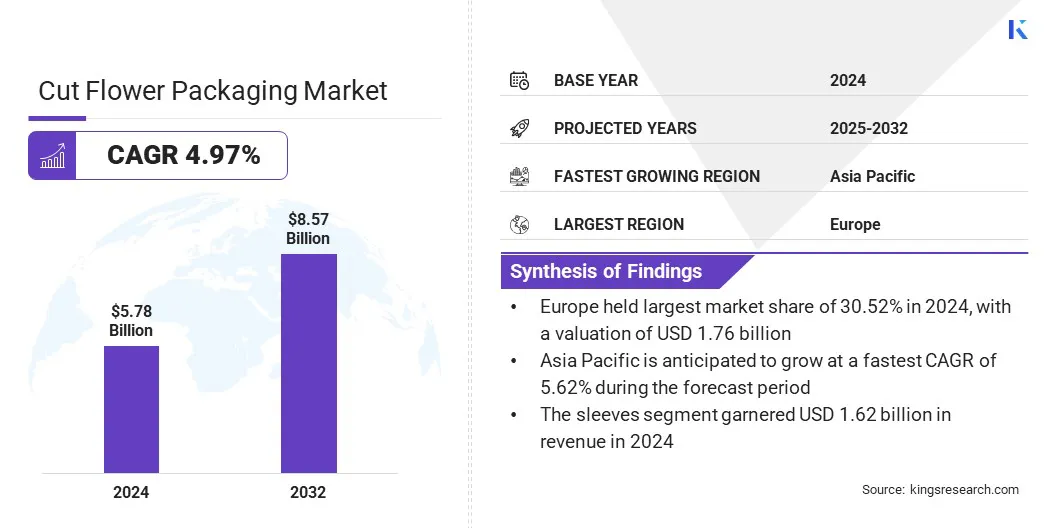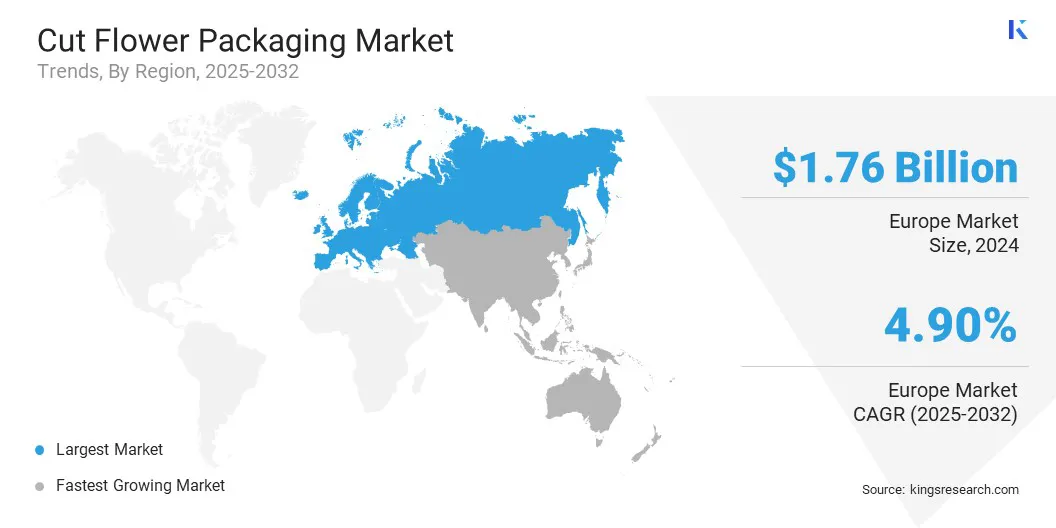Market Definition
Cut flower packaging comprises materials and solutions designed to protect, preserve, and enhance the appearance of freshly cut flowers during handling, transportation, and retail display. It ensures freshness, prevents mechanical damage, and maintains optimal temperature and humidity levels.
Common packaging types include sleeves, wraps, boxes, and cartons made from materials such as plastic films, paperboard, and biodegradable alternatives.
Cut Flower Packaging Market Overview
According to Kings Research, the global cut flower packaging market size was valued at USD 5.78 billion in 2024 and is projected to grow from USD 6.05 billion in 2025 to USD 8.75 billion by 2032, exhibiting a CAGR of 5.78% during the forecast period.
This growth is mainly driven by the rising emphasis on visually refined floral displays that enhance retail presentation. Retailers are focusing on premium, durable packaging solutions to reinforce brand perception and influence consumer purchase behavior.
Major companies operating in the cut flower packaging industry are Smithers-Oasis Company (FloraLife), Koen Pack B.V., DS Smith, Koninklijke Paardekooper Group, Smurfit Kappa Group, UFlex Limited, Sirane Limited, Royal FloraHolland, DECOWRAPS, Stora Enso, Packman Packaging Private Limited, and Nature-Pack Recyclable Packaging.
Key Market Highlights:
- The cut flower packaging market size was recorded at USD 5.78 billion in 2024.
- The market is projected to grow at a CAGR of 5.78% from 2025 to 2032.
- Europe held a share of 30.52% in 2024, valued at USD 1.76 billion.
- The sleeves segment garnered USD 1.62 billion in revenue in 2024.
- The plastic segment is expected to reach USD 3.57 billion by 2032.
- The single segment is anticipated to witness the fastest CAGR of 5.18% over the forecast period.
- The florists segment is projected to hold a share of 40.05% by 2032.
- Asia Pacific is anticipated to grow at a CAGR of 5.62% through the projection period.
The market is influenced by the transition to fibre-based bouquet boxes designed to replace plastic transit packaging. These boxes provide structural integrity, moisture resistance, and visual appeal suited for both retail and e-commerce channels. Their recyclable nature aligns with retailer sustainability targets.
Manufacturers are developing mono-material fibre packaging compatible with automation and cold-chain logistics, enabling eco-friendly distribution while maintaining durability and design quality to meet retailer and consumer preferences for sustainable flower packaging.
- In October 2025, DS Smith, under International Paper, partnered with Queen Flowers to launch a recyclable bouquet box tailored for retail and e-commerce applications. The packaging features a fibre-based structure that enhances product protection, sustainability, and presentation while supporting efficient logistics across the expanding flower packaging industry.

What factors are driving the demand for cold-chain and modified atmosphere-compatible packaging in the cut flower industry?
The increasing need for packaging compatible with cold-chain distribution and modified atmosphere packaging (MAP) technologies is fueling the growth of the cut flower packaging market. These solutions preserve freshness and extend vase life during long-distance transport.
Floriculture exporters and retailers are investing in packaging that maintains temperature and humidity equilibrium. Polymeric films, MAP liners, and insulated corrugated boxes are gaining traction, ensuring consistent quality throughout the supply chain. This shift reflects a growing preference for freshness assurance and product integrity in perishable flower logistics.
- In April 2025, CSIR-CFTRI, Mysuru, developed a paper-based technology named ‘Freshness Keeper’ designed to extend the shelf life of cut flowers. This innovation strengthens cut flower packaging by enhancing freshness retention, supporting the floriculture value chain, and promoting sustainable income growth for flower producers under CSIR’s Floriculture Mission.
What are the key operational challenges affecting the scalability of the cut flower packaging market?
The expansion of the market is hindered by operational inefficiencies arising from seasonal demand variations and fragmented supply networks. Global trade surges during events such as Valentine’s Day and Mother’s Day, creating production and distribution imbalances.
Variations in sourcing regions and packaging standards among growers, exporters, and retailers reduce efficiency and quality consistency. Moreover, the differences in logistics infrastructure further limit standardization, leading to delivery delays, higher transit losses, and restricted scalability for manufacturers aiming to maintain uniform supply coordination across markets.
To address this challenge, manufacturers and distributors are adopting modular packaging formats, digital inventory systems, and standardized compliance frameworks. These initiatives streamline procurement, reduce wastage, and enable scalability across diverse markets and seasonal demand cycles.
How is growing trend toward biodegradable and recycled flower sleeves influencing the market?
Biodegradable and recycled flower sleeves are increasingly preferred as the global focus shifts toward sustainable packaging practices. These alternatives reduce dependency on virgin plastics and align with circular economy objectives. Manufacturers are introducing sleeves made from recycled polyethylene and compostable bioplastics to meet retailer environmental compliance.
They offer comparable transparency and durability to traditional plastic options while lowering carbon emissions. The demand is further boosted by retailer mandates and consumer preference for environmentally responsible floral packaging alternatives that maintain visual quality and freshness.
- In May 2025, Broekhof introduced the Recy Kraft Look sleeve, manufactured from recycled plastic sourced from Dutch flower auctions. This launch reinforces the company’s position in sustainable packaging and marks a key step in eco-friendly flower sleeve development.
Cut Flower Packaging Market Report Snapshot
|
Segmentation
|
Details
|
|
By Type
|
Sleeves, Boxes & Cartons, Wrapping Sheets, Buckets, Others
|
|
By Material
|
Plastic, Paper & Paperboard, Others
|
|
By Form
|
Single, Bouquet
|
|
By Distribution Channel
|
Florists, Supermarkets & Retail Stores, Online
|
|
By Region
|
North America: U.S., Canada, Mexico
|
|
Europe: France, UK, Spain, Germany, Italy, Russia, Rest of Europe
|
|
Asia-Pacific: China, Japan, India, Australia, ASEAN, South Korea, Rest of Asia-Pacific
|
|
Middle East & Africa: Turkey, U.A.E., Saudi Arabia, South Africa, Rest of Middle East & Africa
|
|
South America: Brazil, Argentina, Rest of South America
|
Market Segmentation
- By Type (Sleeves, Boxes & Cartons, Wrapping Sheets, Buckets, and Others): The sleeves segment generated USD 1.62 billion in revenue in 2024, mainly due to the rising use of cost-efficient, transparent, and customizable packaging solutions, enhancing freshness and presentation during retail and distribution.
- By Material (Plastic, Paper & Paperboard, and Others): The paper and paperboard segment is poised to record a CAGR of 5.08% through the forecast period, propelled by increasing demand for recyclable and sustainable alternatives to conventional plastic packaging materials.
- By Form (Single and Bouquet): The bouquet segment is estimated to hold a share of 61.55% by 2032, fueled by high consumer preference for pre-arranged floral products and growing e-commerce sales of ready-to-display bouquets.
- By Distribution Channel (Florists, Supermarkets & Retail Stores, and Online): The florists segment is projected to reach USD 3.43 billion by 2032, owing to expanding retail networks and consistent demand for personalized floral arrangements requiring diverse, premium-quality packaging solutions.
What is the cut flower packaging market scenario in Europe and Asia-Pacific region?
Based on region, the global market has been classified into North America, Europe, Asia Pacific, Middle East & Africa, and South America.

Europe cut flower packaging market share stood at 30.52% in 2024, valued at USD 1.76 billion. This dominance is reinforced by strong retail demand and structured floral distribution networks. Sustainability remains the key priority, prompting packaging manufacturers to adopt recyclable fibre-based materials and mono-material plastic alternatives.
- In October 2025, Roobos Flower Export, in collaboration with Groot Packaging and LS Santini, initiated a circular pilot focused on minimizing the environmental footprint of the floral supply chain and advancing sustainable practices within the cut flower packaging industry.
Retailers are enforcing strict environmental guidelines, prompting suppliers to use lightweight, biodegradable, and FSC-certified packaging formats. The region’s advanced logistics infrastructure and cold-chain infrastructure are fueling the transition to standardized packaging solutions, enhancing supply efficiency and product preservation across the floral value chain.
The Asia-Pacific cut flower packaging market is set to grow at a CAGR of 5.62% over the forecast period. This expansion is stimulated by rapid urbanization, increased consumer expenditure on floral products, and rapid e-commerce penetration.
Regional manufacturers are investing in advanced printing technologies, sustainable films, and paperboard packaging to address evolving buyer preferences.
Growing export activities and temperature-sensitive logistics are leading to increased demand for cost-efficient and durable packaging solutions. Domestic production capacities are expanding to meet large-scale floral exports, while digital supply-chain integration supports efficient inventory management, fostering consistent market development across emerging and developed economies in the region.
Regulatory Frameworks
- In the EU, the Packaging and Packaging Waste Directive (94/62/EC) governs packaging design, material use, and waste management. It promotes recyclability and waste reduction, influencing manufacturers to develop sustainable and compliant cut flower packaging materials.
- In the UK, the Extended Producer Responsibility (EPR) for Packaging Regulations 2024 mandates producers to fund the collection and recycling of packaging waste. This regulation drives cut flower packaging suppliers to adopt recyclable formats and improve supply chain traceability.
- In the U.S., the Resource Conservation and Recovery Act (RCRA) regulates solid waste management, including packaging disposal. It promotes the use of biodegradable and recycled materials in cut flower packaging to minimize landfill impact.
- In Canada, the Single-Use Plastics Prohibition Regulations (SOR/2022-138) enforce restrictions on non-recyclable plastics. The regulation compels cut flower packaging manufacturers to replace conventional plastics with sustainable alternatives such as fibre-based or compostable materials.
- In Japan, the Containers and Packaging Recycling Law mandates proper segregation and recycling of packaging waste. It ensures that cut flower packaging producers support recycling systems and develop eco-efficient materials aligned with national waste management standards.
- In Australia, the National Packaging Targets 2025 framework establishes goals for packaging recyclability and compostability. It requires cut flower packaging manufacturers to achieve 100% reusable, recyclable, or compostable packaging by 2025, reinforcing the shift toward circular economy practices.
Competitive Landscape
Key companies operating in the cut flower packaging market are expanding production facilities for fibre-based and recycled packaging materials to meet sustainability mandates. Strategic collaborations between packaging manufacturers and floral distributors are fostering customized, secure, and visually appealing packaging solutions.
Firms are investing in automation, digital printing, and eco-design technologies to improve operational efficiency and reduce lead times. Continuous innovation in moisture-resistant and biodegradable materials remains a key focus, supported by data-driven supply-chain systems to ensure consistent global distribution.
- In October 2024, FloraLife, a division of Smithers-Oasis Company, introduced a new film for its Flower Food packets containing 51.3% recycled materials. The shift toward recycled content reduced greenhouse gas emissions by 12% and fossil fuel consumption by 20%, demonstrating the environmental impact of sustainable material innovation.
List of Key Companies in Cut Flower Packaging Market:
- Smithers-Oasis Company (FloraLife)
- Koen Pack B.V.
- DS Smith
- Koninklijke Paardekooper Group
- Smurfit Kappa Group
- UFlex Limited
- Sirane Limited
- Royal FloraHolland
- DECOWRAPS
- Stora Enso
- Packman Packaging Private Limited
- Nature-Pack Recyclable Packaging
Recent Developments
- In October 2025, Dutchess Bouquets, in partnership with FlowerBox and Graphic Packaging International, launched the IntegraVase Arrangement, a 100% recyclable paperboard vase with an integrated fibre liner.
- In July 2025, LBS acquired Pilgrim Packaging, a floral supplier to strengthen LBS’s presence in the flower packaging industry through expanded in-house converting capabilities and enhanced production capacity for specialized, high-quality packaging solutions tailored to floral industry requirements.


